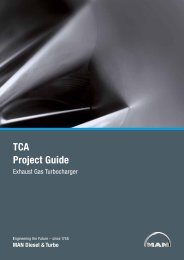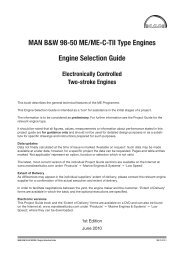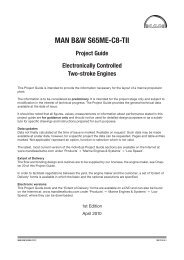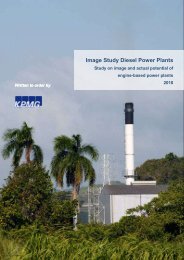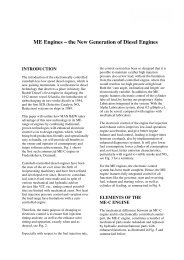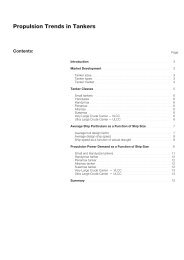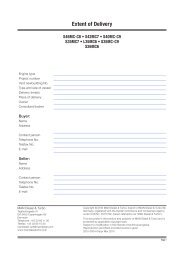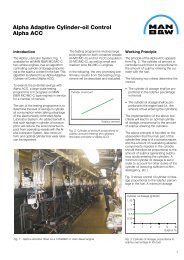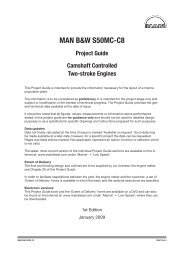- Page 1 and 2:
MAN B&W S65ME-C8-GI-TII Project Gui
- Page 3:
MAN B&W Engine Design .............
- Page 6 and 7:
MAN B&W Contents Chapter Section 5
- Page 8 and 9:
MAN B&W Contents Chapter Section 13
- Page 11 and 12:
MAN B&W Index Subject Section Subje
- Page 13 and 14:
MAN B&W Index Subject Section Subje
- Page 15 and 16:
MAN B&W Index Subject Section Subje
- Page 17:
MAN B&W Index Subject Section Subje
- Page 21 and 22:
MAN B&W 1.00 ME�GI Dual Fuel Engi
- Page 23 and 24:
MAN B&W 1.01 ME Advantages The adva
- Page 25 and 26:
MAN B&W 1.02 Engine Type Designatio
- Page 27 and 28:
MAN B&W 1.04 Engine Power Range and
- Page 29 and 30:
MAN B&W Performance Curves
- Page 31 and 32:
MAN B&W 1.06 Cylinder Liner The cyl
- Page 33 and 34:
MAN B&W 1.06 Auxiliary Blower The e
- Page 35 and 36:
MAN B&W 1.06 This</
- Page 37 and 38:
MAN B&W 1.06 The double�wall pipi
- Page 39:
MAN B&W Engine Layout and Load Diag
- Page 42 and 43:
MAN B&W 2.01 placed on the light ru
- Page 44 and 45:
MAN B&W 2.02 Constant ship speed li
- Page 46 and 47:
MAN B&W 2.04 Engine Layout and Load
- Page 48 and 49:
MAN B&W 2.04 Line 4: Represents the
- Page 50 and 51:
MAN B&W 2.04 110 100 90 80 70 60 50
- Page 52 and 53:
MAN B&W 2.04 Example 2: Special run
- Page 54 and 55:
MAN B&W 2.04 Example 4: Special run
- Page 57 and 58:
MAN B&W 2.05 Diagram for actual pro
- Page 59 and 60:
MAN B&W 2.07 SFOC for High Efficien
- Page 61 and 62:
MAN B&W 2.08 Examples of Graphic Ca
- Page 63 and 64:
MAN B&W 2.09 SFOC for S65ME-C8/-GI
- Page 65 and 66:
MAN B&W 2.10 Diagram b Reduction of
- Page 67:
MAN B&W 2.12 Emiss
- Page 71 and 72:
MAN B&W 3.01 Turbocharger Selection
- Page 73 and 74:
MAN B&W 3.02 Turbocharger MAN B&W S
- Page 75:
MAN B&W 3.03 Air Orifice Air Proces
- Page 79 and 80:
MAN B&W 4.01 Electricity Production
- Page 81 and 82:
MAN B&W 4.01 Designation of PTO For
- Page 83 and 84:
MAN B&W 4.01 The power from the cra
- Page 85 and 86:
MAN B&W 4.02 � � � � � Th
- Page 87 and 88:
MAN B&W 4.03 Pos. 1 Special face on
- Page 89 and 90:
MAN B&W 4.03 DMG/CFE Generators Opt
- Page 91 and 92:
MAN B&W 4.03 In such a case, the pr
- Page 93 and 94:
MAN B&W 4.04 combinator mode. <stro
- Page 95 and 96:
MAN B&W Waste Heat Recovery Systems
- Page 97 and 98:
MAN Diesel 4.06 L16/24 GenSet Data
- Page 99 and 100:
MAN Diesel 4.07 L21/31 GenSet Data
- Page 101 and 102:
MAN Diesel 4.07 L21/31 GenSet Data
- Page 103 and 104:
MAN Diesel 4.08 L23/30H GenSet Data
- Page 105 and 106:
MAN Diesel 4.09 L27/38 GenSet Data
- Page 107 and 108:
MAN Diesel 4.09 L27/38 GenSet Data
- Page 109:
MAN Diesel 4.10 L28/32H GenSet Data
- Page 113 and 114:
MAN B&W 5.01 Space Requirements and
- Page 115 and 116:
MAN B&W 5.02 Cyl. No. 5 6 7 8 A 1,1
- Page 117 and 118:
MAN B&W 5.03 Crane beam for turboch
- Page 119 and 120:
MAN B&W 5.04 Engine room crane The
- Page 121 and 122:
MAN B&W 5.04 MAN B&W Double�Jib C
- Page 123 and 124:
MAN B&W 5.06 Engine and Gallery Out
- Page 125 and 126:
MAN B&W 5.06 3,560 2,358 400 400 50
- Page 127 and 128:
MAN B&W 5.08 Mass of Water and Oil
- Page 129 and 130:
MAN B&W 5.09 6,244 (AD) 6,171 (X, F
- Page 131 and 132:
MAN B&W 5.10 Counterflanges MAN B&W
- Page 133 and 134:
MAN B&W 5.10 Counterflanges, Connec
- Page 135 and 136: MAN B&W 5.10 MHI Type MET Fig. 5.10
- Page 137 and 138: TCA MAN B&W 5.10 ABB Type TPL TPL T
- Page 139 and 140: MAN B&W 5.11 Engine Seating and Hol
- Page 141 and 142: MAN B&W 5.12 Engine Seating Profile
- Page 143 and 144: MAN B&W 5.13 Engine Top Bracing The
- Page 145 and 146: MAN B&W 5.14 Mechanical Top Bracing
- Page 147 and 148: MAN B&W 5.16 Components for Engine
- Page 149 and 150: MAN B&W 5.16 EICU (Engine Interface
- Page 151 and 152: MAN B&W 5.17 Shaftline Earthing Dev
- Page 153 and 154: MAN B&W 5.17 When a generator <stro
- Page 155 and 156: MAN B&W 5.18 Data Sheet for Propell
- Page 157 and 158: MAN B&W 5.18 Servo oil system for V
- Page 159 and 160: MAN B&W 5.18 Alphatronic 2000 Propu
- Page 161: MAN B&W 5.18 Renk KAZ Clutch for au
- Page 165 and 166: MAN B&W 6.01 Calculation of L<stron
- Page 167 and 168: MAN B&W 6.03 List
- Page 169 and 170: MAN B&W 6.03 List
- Page 171 and 172: MAN B&W 6.04 Auxiliary Machinery Ca
- Page 173 and 174: MAN B&W 6.04 Calculation of L<stron
- Page 175 and 176: MAN B&W 6.04 Freshwater Generator I
- Page 177 and 178: MAN B&W 6.04 Calculation of Freshwa
- Page 179 and 180: MAN B&W 6.04 ∆m M% = 14 x ln (P M
- Page 181 and 182: MAN B&W 6.04 Calculation of Exhaust
- Page 183: MAN B&W MAN Diesel Fuel 7
- Page 188 and 189: MAN B&W 7.00 As can be seen in Fig.
- Page 190 and 191: MAN B&W 7.01 Fuel Oil System No val
- Page 192 and 193: MAN B&W 7.02 Fuel Oils Marine diese
- Page 194 and 195: MAN B&W 7.04 Fuel Oil Pipe Insulati
- Page 196 and 197: MAN B&W 7.04 Fuel Oil Pipe Heat Tra
- Page 198 and 199: MAN B&W 7.05 Fuel Oil Heater The he
- Page 200 and 201: MAN B&W 7.06 Water In Fuel Emulsifi
- Page 202 and 203: MAN B&W Reliquefaction Technology W
- Page 204 and 205: MAN B&W LNG Carriers LNG carriers,
- Page 206 and 207: MAN B&W This</stron
- Page 208 and 209: MAN B&W 7.09 % of full engine load
- Page 210 and 211: MAN B&W 7.09 Safety aspects The com
- Page 212 and 213: MAN B&W 7.09 3,650 Motor Motor Inte
- Page 215: MAN B&W MAN Diesel Lubricating Oil
- Page 218 and 219: MAN B&W 8.02 Hydraulic Power Supply
- Page 220 and 221: MAN B&W 8.03 Lubricating Oil Pipes
- Page 222 and 223: MAN B&W 8.04 Lubricating Oil Centri
- Page 224 and 225: MAN B&W 8.05 Lubricating oil full f
- Page 226 and 227: MAN B&W 8.06 Lubricating Oil Tank
- Page 228 and 229: MAN B&W 8.07 Crankcase Venting and
- Page 230 and 231: MAN B&W 8.09 Separate System for Hy
- Page 232 and 233: MAN B&W 8.09 �������
- Page 235: MAN B&W MAN Diesel Cylinder Lubrica
- Page 238 and 239:
MAN B&W 9.02 MAN B&W Alpha Cylinder
- Page 240 and 241:
MAN B&W 9.02 Cylinder Oil Pipe Heat
- Page 242 and 243:
MAN B&W 9.02 Flow sensor AC Page 5
- Page 245:
MAN B&W MAN Diesel Pis</str
- Page 249:
MAN B&W MAN Diesel Central Cooling
- Page 252 and 253:
MAN B&W 11.02 Central Cooling Water
- Page 254 and 255:
MAN B&W 11.03 Jacket water system D
- Page 257 and 258:
MAN B&W 12.01 Seawater Systems The
- Page 259 and 260:
MAN B&W 12.03 Seawater Cooling Pipe
- Page 261 and 262:
MAN B&W 12.05 Jacket Cooling Water
- Page 263 and 264:
MAN B&W 12.07 Components for Jacket
- Page 265:
MAN B&W 12.08 Temperature at Start
- Page 269 and 270:
MAN B&W 13.01 Starting and Control
- Page 271 and 272:
MAN B&W 13.03 Starting and Control
- Page 273:
MAN B&W 13.04 Electric Motor for Tu
- Page 277 and 278:
MAN B&W 14.01 Scavenge Air System S
- Page 279 and 280:
MAN B&W 14.02 Control of the Auxili
- Page 281 and 282:
MAN B&W 14.04 Electric Motor for Au
- Page 283 and 284:
MAN B&W 14.05 Auto Pump Overboard S
- Page 285 and 286:
MAN B&W 14.07 Fire Extingui
- Page 287:
MAN B&W MAN Diesel Exhaust Gas 15
- Page 290 and 291:
MAN B&W 15.02 Exhaust Gas Pipes Exh
- Page 292 and 293:
MAN B&W 15.02 Cleaning Systems Wate
- Page 294 and 295:
MAN B&W 15.04 Components of the Exh
- Page 296 and 297:
MAN B&W 15.05 Calculation of Exhaus
- Page 298 and 299:
MAN B&W 15.05 Pressure losses and c
- Page 300 and 301:
MAN B&W 15.06 F2 MAN B&W S65ME-C8/-
- Page 303:
MAN B&W MAN Diesel Engine Control S
- Page 306 and 307:
MAN B&W 16.01 2) Low NO x em<strong
- Page 308 and 309:
MAN B&W 16.01 ME�GI operational p
- Page 310 and 311:
MAN B&W 16.01 Mechanical�hydrauli
- Page 312 and 313:
MAN B&W 16.01 Engine Control System
- Page 314 and 315:
MAN B&W 16.01 Pneumatic Manoeuvring
- Page 316 and 317:
MAN B&W 16.02 Dual Fuel Control Sys
- Page 318 and 319:
MAN B&W 16.02 Safe condition/ purge
- Page 321:
MAN B&W MAN Diesel Vibration Aspect
- Page 324 and 325:
MAN B&W 17.02 2nd Order Moments on
- Page 326 and 327:
MAN B&W 17.02 1st Order Moments on
- Page 328 and 329:
MAN B&W 17.03 Moment compensator Af
- Page 330 and 331:
MAN B&W 17.05 Guide Force Moments T
- Page 332 and 333:
MAN B&W 17.05 As the deflection sha
- Page 334 and 335:
MAN B&W 17.06 Critical Running When
- Page 337:
MAN B&W Monitoring Systems and Inst
- Page 340 and 341:
MAN B&W 18.02 PMI System, Type PT/S
- Page 342 and 343:
MAN B&W 18.03 CoCoS Systems The Com
- Page 344 and 345:
MAN B&W 18.04 Alarm - Slow Down and
- Page 346 and 347:
MAN B&W 18.04 Alarms for UMS - Clas
- Page 348 and 349:
MAN B&W 18.04 Alarms for UMS - Clas
- Page 350 and 351:
MAN B&W 18.04 Shut down for AMS and
- Page 352 and 353:
MAN B&W 18.05 Local instruments Rem
- Page 354 and 355:
MAN B&W 18.06 Other Alarm Functions
- Page 356 and 357:
MAN B&W 18.06 Bearing Wear Monitori
- Page 358 and 359:
MAN B&W 18.06 Control Devices Senso
- Page 360 and 361:
MAN B&W Diesel A/S 18.08 Safety Asp
- Page 362 and 363:
MAN B&W Diesel A/S 18.08 External S
- Page 365 and 366:
MAN B&W 19.01 Disp
- Page 367 and 368:
MAN B&W 19.02 Specification for pai
- Page 369 and 370:
MAN B&W Dispatch P
- Page 371 and 372:
MAN B&W 19.06 List
- Page 373 and 374:
MAN B&W 19.07 Exhaust valve, <stron
- Page 375 and 376:
MAN B&W 19.08 Table B: Page 2 of 2
- Page 377 and 378:
MAN B&W 19.10 List
- Page 379:
MAN B&W MAN Diesel Project Suppport
- Page 382 and 383:
MAN B&W 20.02 Computeris</s
- Page 384 and 385:
MAN B&W 20.03 Copenhagen Standard E
- Page 386 and 387:
MAN B&W 20.04 Main Section 939 Engi
- Page 388 and 389:
MAN B&W 20.04 Engine production and
- Page 391 and 392:
MAN B&W Appendix A Symbols for Pipi
- Page 393:
MAN B&W Appendix A No. Symbol Symbo



